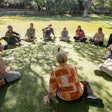
Want more content like this sent directly to your inbox? Then sign up for our brand-new BizBash Meetings & Trade Shows monthly newsletter to stay in the know on the latest news and ideas from the most innovative meetings and trade shows.
To get a clearer picture of what the future holds during a period of so much uncertainty, BizBash launched a series of articles where top professionals from all aspects of the event industry share their predictions and insights for the year ahead. Previously, we caught up with trade show producers, destination meeting planners, catering professionals, experiential marketers, event designers and audiovisual producers.
Now, we're chatting with some of the industry's top association planners. Here's an in-depth look at what five experts around the country are expecting to see in 2022.
It’s all about member engagement right now.
Catie Duhon, the president of event and association management company International Meeting Managers, is seeing association events ramping back up slowly—with the most successful ones having an emphasis on membership engagement. “For most industries, there are both members who have moved on and many new faces, so networking and building new relationships within existing structures seems to be important,” she says. “Education is still important, but it seems to be more peer-to-peer sharing versus speakers and experts.
Francesca Radabaugh, COO and president of association management at Paragon Events, agrees, noting that association events need to focus on “that spirit of connection and connectedness. Membership organizations are about being a part of something bigger, sharing ideas around a common cause, camaraderie with people who are in your same sphere,” she points out. “Now that restrictions are lifting and fear is easing, it makes space for event planners to do what they do best—bring people together around a common purpose.”
The ultimate goal, Radabaugh adds, is to allow people to rebond with other members, and with the association as a whole. “If associations can come out strong and create these spaces to reconnect, members will be grateful and loyal long term. There is nothing more bonding than going through a shared experience together and coming out the other side stronger,” she says.
Attendees want spaces to network and socialize.
“An increased emphasis on (safe) networking and socialization will be vital to member engagement as we get started again,” says Trey Weaver, meetings manager for the American Academy of Forensic Sciences. “Make sure there are times and spaces dedicated to this!”
Radabaugh points out that in the virtual sphere, for the most part, members’ education needs have been met. “The part that members and attendees are craving and haven’t been as easily satiated for is to network—just being able to catch up, connect and have a conversation like they used to,” she says. “In a virtual environment, those types of interactions require a lot of organization and structure to not be clunky, which can take away from the more natural experience people are used to. ... I think there is going to be a noticeable spike in participation at noneducational programs—anything networking, social or activity-based where people are able to just talk and catch up is going to be a huge crowd pleaser.”
Panels and forecasting sessions are popular right now.
Duhon is finding that when education does come in, panel discussions seem to be especially appealing at the moment. “More than ever, I think people are interested in knowing how their own experience relates to that of their peers, and in learning best practices and new ideas,” she says. “We are also seeing a lot of 'outlook' and 'forecasting' in session titles as everyone looks ahead to what is next and how everyone is recovering.”
Many members are eager to return to face-to-face events—but technological advancements are here to stay.
While Duhon expects that many smaller board and committee meetings will stick with a hybrid or remote component, for the sake of convenience and efficiency, larger gatherings are likely to return in person.
Weaver is observing something similar. “As much as we've made some brilliant progress in virtual connectivity during the past couple of years, there are elements that still cannot yet be replicated through a video call,” he says. “That being said, the advances in technology for virtual/hybrid are making it more important than ever before for technological integration/enhancement of our in-person events. Members want connectivity, they want information at their fingertips (they want Wi-Fi).”
Weaver predicts that many of the visual and interactive enhancements that have been developed for the virtual/hybrid format will continue to be present as in-person events return. “Remote environments are also playing heavily into this,” he points out. “I see a lot more attendees who need to balance work demands more than before, because now the expectation is wherever they are, even when at an event, they need to make time and be available for their job.”
Lindsay Schattenstein, senior event manager for the NFL Players Association, agrees that members are looking for more flexibility and an increase in technology right now. “There needs to be an understanding that there is some population of each event’s attendees that will appreciate having a hybrid option—you just have to weigh the cost-benefit and understand your specific demographics to know if investing the time and energy (and money!) into creating a hybrid experience is worthwhile," she explains. "At the beginning of the pandemic, people were so isolated that they were jumping at any chance to engage. Now, as we move into the next phase of life, we have to come to grips with the fact that members are still going to be looking for a sense of work-life balance in the agenda.”
But, people expect real value if they’re going to attend in person.
Lauren Parr, the American Geophysical Union’s senior vice president of meetings and learning, thinks virtual is here to stay in the association world. “We believe that virtual attendees are key to the diverse and inclusive meetings we want to convene, and we’re hoping that we continue to find technology and design that can continue to support that," she says. “Our communities want to connect, and they want to do it on their terms, and people will remain choosy about what they travel to—thus, the need for a high-quality virtual option that complements the in-person experience will remain.”
Radabaugh agrees. “Hybrid events are going to be a staple going forward. For attendees, the convenience and reduced cost to participate in virtual offerings make it hard to put the genie back in the bottle when it comes to living/in-person events,” she explains. “I’m also interested to see what the demographics show—if there is a generational divide between those who attend in person versus virtual."
She continues: "In the overall grand scheme of things, live events are definitely coming back full force, but associations now have the added tool in their toolkit of robust virtual programs. Associations that are smart will be sure to leverage both options' strengths to their advantage.”
Weaver is finding that having some sort of “wow” factor can motivate attendees to choose an in-person option over a virtual option. “I think destination choice will help here, as folks have certainly felt cooped up for the past couple of years,” he says. “I know this isn't always feasible, but finding hotels/locations/destinations that even offer a bit of that 'travel-excitement'-type of feel/amenities/partnerships will not only attract folks, but keep them in higher spirits during your event—which means you can get them involved in so much more.”
Budgets will likely have a big impact on association event formats for the next few years.
Of course, creating a “wow” factor often requires a robust budget—as does offering a robust hybrid experience. Budgets are certainly top of mind for association planners right now, says Weaver.
“I can absolutely see the next couple of years as shaping our industry in this area—and the resulting impact setting the standard for pretty much the foreseeable future—especially for associations, where often you have this juxtaposition of organizations that might not always be able to afford a fully immersive hybrid experience, mixed with companies that don't want to spend the travel budget when there's an online option, [as well as] individuals who may not be able to afford to do in-person on their own,” he predicts. “It's unfortunate because being able to offer hybrid events can really help associations and nonprofits in expanding their mission reach so much farther than before, but the pandemic has driven the costs of these elements up so substantially that the groups who could benefit the most from using them often can't afford it.”
But, adds Schattenstein, “My hope is that people outside of the hospitality industry continue to see the value in meeting face to face. Although there is continued scrutiny in many companies for budget on travel, and technology continues to evolve with virtual events, for some engagements there is no substitute!”
Support and empathy are key right now.
Regardless of how your members are meeting, it’s important to understand the impact the last two years have had on them. “Understanding the environment our communities are operating in is key,” says Parr. “In academia, we understand that our members are really fatigued and balancing work and lives in a time of continuing uncertainty. They’re eager to return to meetings and need our support in making sure we’re not overburdening speakers or even attendees with complicated processes.”
Weaver suggests focusing your event messaging on ways that getting re-involved in your association can provide support. “Understand what's impacted your members the most during the pandemic years, what they feel they've missed out on the most from the association and what it would take to make events/programs feel safe and accessible,” he says.
Association leaders should be taking stock of what’s most important to their members.
Along the same lines, our experts note that associations should be taking a step back and evaluating how they can best serve their members right now. “Most often it is either education or relationships. Whatever it may be, lean into that for a season—feed the most immediate need first, then build back up to a more comprehensive slate of offerings,” Duhon suggests. “Connection and community remain the heart of most associations, so be sure to communicate your support for your members and continue providing those connection opportunities—even if small or simple.”
Radabaugh hopes the pandemic has forced associations and their members to refocus and recenter on what’s important. “People are not the same as they were two years ago—what drives them and what they value has likely changed—but if they are a part of an association you know they have at least one thing in common,” she points out. “And if you make sure that you keep that commonality—that mission and purpose—at the front and center, you will fulfill an important need for your members and other attendees.”
And don’t neglect the lessons we’ve learned about equity and inclusion. Says Schattenstein: “One other huge area where the event industry has begun to focus on and I hope receives even more support as we move through the year is on diversity and inclusion. We need to not just be bringing diverse voices to the table, but actually make sure they are heard."
Moving forward, transparency is key.
After years of uncertainty, Parr is hoping to get back an element of predictability for the industry, and for attendees. “We all need some sort of predictability in this environment, and we’ve struggled as an industry to evolve our business models in a manner that creates shared risk and a win-win across all partners,” she reflects. “Over the course of the pandemic, we repeatedly heard the call for new models—but we haven’t made it there, and I’d even say that contracts and business agreements are even more difficult to negotiate now.”
Her solution? “It would be wonderful if we can talk openly and honestly about risk and rewards, and figure out new ways of working together that would protect and benefit all parties.”
But this is also a time for innovation.
While there’s that desire to get back to “normal,” Weaver hopes that the association industry doesn’t lose sight of the innovation it has displayed. “We've seen such amazing progress from technology and other services as we had to adapt at breakneck speed to a virtual world. I'd love to see that creativity and resourcefulness continue to be applied to the tools and products we utilize for the in-person and hybrid models as well,” he says.” I absolutely want to see hybrid opportunities take associations to the next level of membership recruitment, retention, involvement and donor cultivation.”
He adds: “With that, though, I deeply hope to see more of these tech and service companies working to understand and truly partner with associations, and the unique challenges and opportunities that come from the association world.”



















